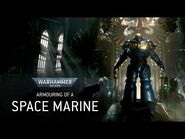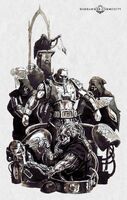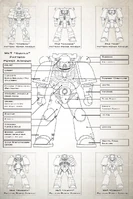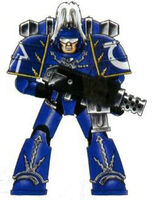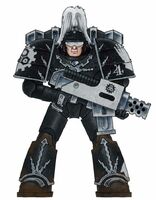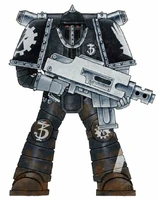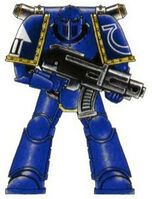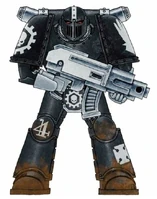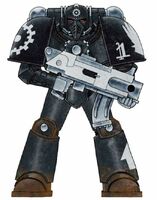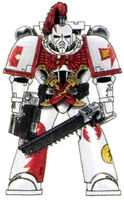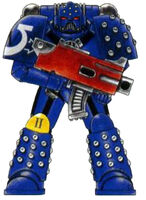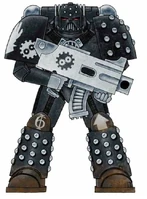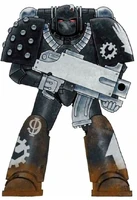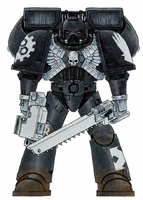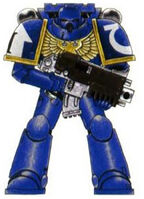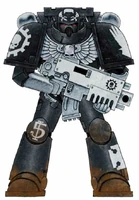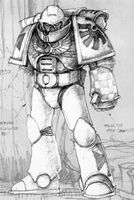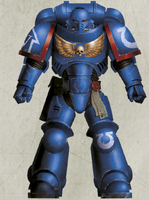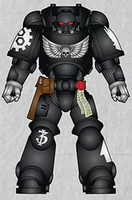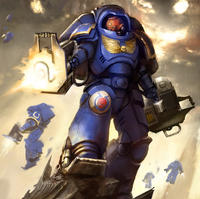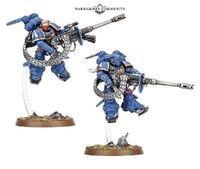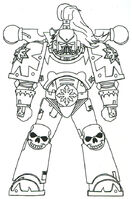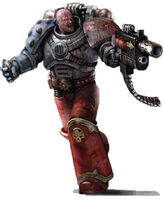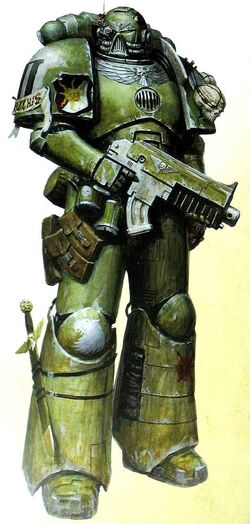
Firstborn Space Marine Brother Kalius of the Raptors Chapter, 3rd Company, 2nd Tactical Squad, deployed during the Taros Campaign, wearing a modified suit of Mark VII Aquila Power Armour.
Power armour is an advanced form of powered combat armour, worn primarily by the Space Marines and the Chaos Space Marines, though suits have been created to be worn by mere mortals. It is a completely enclosed suit of combat armour composed of shaped adamantium and plasteel plates, encased in a ceramite ablative layer.
Each suit possesses a full suite of life-support functions for operation in hostile environments, an automated medicae system to provide some level of first aid to a wounded wearer and a highly advanced and fully integrated tactical targeting and threat analysis system known as "auto-senses."
The suit would be heavy and cumbersome to wear but for the electrically-motivated fibre bundles within the armour that replicates the wearer's movement and enhances their strength beyond its already considerable superhuman baseline (for Space Marines).
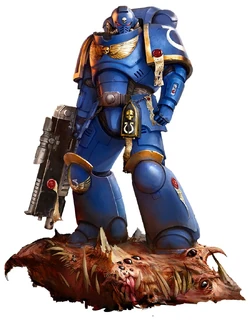
A Primaris Space Marine Intercessor of the Ultramarines Chapter wearing Mark X Tacticus Power Armour.
Rather than simply being worn, a Space Marine's armour integrates with him. It can take many solar decades to forge a single suit of power armour, and each is maintained with absolute care and devotion by skilled Chapter serfs or even the Space Marines themselves. Each suit is a unique artefact with a spirit and history deeply valued by its Chapter.
Power armour has a range of auxiliary systems that improve the Space Marine's effectiveness, including auto-senses made up of thought-activated communications systems, augurs, audio filters, targeting reticules and numerous other features.
Life support functions include pain suppressors, combat stimulants and anti-venoms. Reinforced greaves incorporate gyroscopic stabilisers and power units that magnetise the soles of the armour's boots for zero-gravity and vacuum combat.
Primaris Space Marines now wear modular Mark X Power Armour. This highly flexible protective system can be modified and upgraded to suit the needs of the battlefield. Mark X Tacticus Power Armour is the most common Mark X variant, and is worn by Intercessors, among others.
Mark X Phobos Power Armour is lighter and heavily streamlined. With greater mobility and servo-motors engineered to be silent, it is used most optimally in stealth and infiltration missions, often by Reivers and Vanguard Space Marines.
The Mark X Gravis and Omnis variants may be bulky but are also enormously sturdy, allowing the wearer to stride into the most furious firestorms and harrowing orbital drops and emerge unscathed.
Whilst power armour is most commonly associated with the Space Marines of the Adeptus Astartes, the Sisters of Battle and many Inquisitors also use powered armour of one sort or another.
Typically, however, these armours may not contain the same strength-enhancing properties or life-support functions of Space Marine power armour, nor do they always provide the same level of protection or mobility.
Design
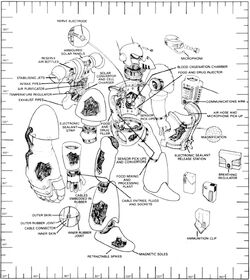
Schematics of Mark VI Corvus Pattern Power Armour
The enclosing suits of armour worn by Space Marines are made from thick ceramite plates and would be cumbersome but for electrically motivated fibre bundles that replicate the movements of the wearer and supplement his strength.
The last gene-seed organ to be implanted in a Space Marine -- the Black Carapace -- rests beneath the skin, itself fitted with neural sensors and transfusion ports.
These plug-in points mesh with Space Marine power armour, linking the wearer's nervous system to his suit's mind impulse controls, turning the suit into a second skin that moves with all the speed and precision of the battle-brother's own body.
Without the Black Carapace, Space Marine power armour is almost useless, and it is therefore the most distinctive feature of a Space Marine and the true mark of the Adeptus Astartes.
There are several patterns (or "marks") of power armour, whose appearances differ significantly. Many older marks have special associations for certain Chapters and are often worn by their ceremonial honour guards or elite units.
Power armour is maintained by skilled Artificers who are not Space Marines, but normal Human servants who spend their lives working for the Chapter. Especially talented Artificers are justly celebrated, and examples of their work highly prized.
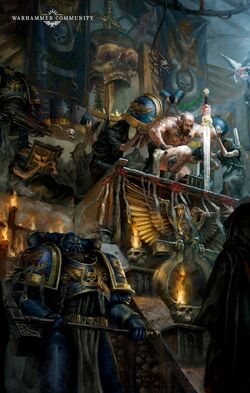
Chapter serfs aid a Firstborn Space Marine of the Ultramarines in putting on his power armour; this often takes the form of an elaborate ritual in which the Emperor is venerated and the goodwill of the armour's Machine Spirit is sought before its activation -- see "Videos" below.
Elements of ancient armour are religiously hunted down, for they carry both the history of the Chapter and the deeds of heroic individuals. Such pieces are lovingly restored and painstakingly engraved with new designs.
As a result, it is quite common to find power armour that combines pieces from different marks, every greave and gorget a recollection of mighty deeds and battles won.
Power armour is fully sealed, isolating the wearer from the outside environment and protecting him from chemical and/or biological weapons and toxic atmospheres. It also commonly includes numerous auxiliary systems such as radio frequency communicators, auto-senses, etc.
Space Marines go through an arduous process where they receive various biogenetically-engineered implants culminating with the implantation of the Black Carapace which allows the Astartes a direct and instinctual neural interface with his power armour, transforming it into effectively a second skin.
The advanced systems of Space Marine power armour also monitor the Astartes' biological functions, feeding the collected medical information to the wearer and, if necessary, to the Chapter's Apothecaries when he is wounded.
The armour's backpack contains the suit's main power source -- a sub-atomic microfusion generator and a back-up solar power converter and 100 solar cell batteries to store the absorbed solar energy.
The backpack also contains the armour's environmental and life support systems and additional movement stabiliser thrusters for low and zero-gravity combat.
Common Components of Space Marine Power Armour
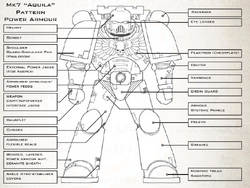
An Adeptus Mechanicus schematic of the common components that make up a set of Mark VII Aquila Power Armour.
All patterns of Adeptus Astartes power armour possess the following components:
- Helmet - The armoured reinforced headgear that protects an Astartes' head.
- Auto-senses - A Space Marine's helmet contains most of his armour's combat systems, all of which are referred to by one title -- Auto-senses. These include thought-activated comm-augers and audio-filters, targeting reticules and range finders, tactical displays and auspex-links, and a host of other features that further enhance the Space Marine's already superhuman senses.
- Photolenses - The photolenses are the reinforced eye guards in the helmet that protect the Space Marine from dazzling light bursts. They also allow him to see into the infrared and ultraviolet ranges, as well as enabling vision in low-light conditions.
- Respirator Vox Grill - The vox grill can amplify a Space Marine's battle cries to deafening volumes. It also contains a respirator to filter out toxins and can be shut off with a thought, drawing instead upon an internal oxygen supply.
- Gorget - Part of the armour that protects the throat.
- Pauldron - The auto-reactive shoulder guards are shaped to deflect as well as absorb incoming blows, these shoulder plates typically display Adeptus Astartes identification markings, including Chapter symbols, company and squad markings, as well as many other honour badges.
- Gauntlet - The armoured glove that protects both the hand and the wrist.
- Cuisses - The part of the armour that protects the thigh.
- Plastron - The armoured chestplate that is designed to protect the suit's armoured power cables, and more importantly, the Astartes vital organs. It is typically adorned with the Imperial Aquila or the Imperialis honour for more veteran Space Marines.
- Couter - Part of the armour that protects the elbow.
- Vambrace - Part of the armour that protects the forearm.
- Poleyn - Part of the armour that protects the knee.
- Greaves - Part of the armour that protects the lower leg. The greaves incorporate gyroscopic stabilisers and power units that can magnetise the soles of the armour's boots for combat in zero-gravity or other unstable conditions.
- Sabaton - The armoured boot that protects the foot.
- Backpack Power Unit- This backpack houses the primary power core for Space Marine armour, as well as reserve cells and an emergency solar collector.
- Life Signs Monitor - Adeptus Astartes power armour contains a suite of life-support functions, including an auto-medicae equipped with various painkillers, combat stimulants and anti-venoms.
- Temperature Regulator - Astartes power armour automatically maintains the Space Marine's temperature. Heat is provided by the power core and thermal build-up can be vented via the backpack's distinctive nozzles. As a result, a Space Marine can fight anywhere, in the cold vacuum of space or the raging heart of a volcano, without even noticing the change of temperature.
- Nutrient Reservoir - Astartes power armour contains a self-replenishing, high-energy liquid food store that can sustain a Space Marine's metabolism without need for further nourishment. During battle, there is no need for a Space Marine to stop to eat or drink.
Space Marine Power Armour Technical Specifications

Space Marine Power Armour Component Diagram
- Mark VII Aquila Power Armour - The Space Marine depicted to the right wears a suit of Mark VII Aquila Power Armour, sometimes called "Armorum Impetor" or "Aquila Armour", although with this particular set depicted here the Chapter Artificers have replaced the breastplate with one converted to fit from an older suit of Mark V Heresy Power Armour, with the reintegration of the chest Aquila and the suit's power cables relocated to the interior. All of the established marks of Space Marine power armour have many variants. Some do not contain all of the original features of that design, while others, as in this case, utilise parts recovered from older marks of armour. Power armour is usually personalised by each Space Marine who wears it and is always revered as a sacred relic of the Chapter. Suits or parts of suits can be ancient, dating all the way back to the time of the Great Crusade or the Horus Heresy, and are often reused many times. Like all power armour, the suit depicted here contains an exoskeletal array of actuators and fibre bundles which replicate the muscular commands via a cybernetic neuronal interface that literally plugs into the wearer's spinal column through the Astartes gene-seed organ implant known as the Black Carapace and connects to his central nervous system. Through this interface, the heavy armour becomes a literal part of the wearer and responds to his movements and mind-impulse controls without adding any encumbrance, despite the armour's weight when inert. Whilst appearing heavy and unwieldy, this Space Marine will experience little weight gain and retains almost his full array of unarmoured movement and agility. The muscle fibre bundles and actuators actually increase the already considerable genetically-enhanced strength of the wearer, allowing him to lift heavier loads or jump greater distances than when not wearing the suit. The outer, armoured layer of this armour consists of shaped adamantium and plasteel plates, encased in a ceramite ablative layer. The armour is shaped to deflect as well as to absorb the energy of incoming blows. The shoulder plates of this suit contain small, auto-responsive plates which burst outwards in a micro-explosion to counteract the energy of an incoming attack and prevent penetration. Beneath the armoured protection lies the internal workings of the suit's life support and combat systems. The armour contains numerous life support systems. The lower back holds a liquid high-protein food store, which when combined with the Space Marine's genetically-enhanced metabolism produces no waste and keeps a Space Marine's body functioning without the need for any other nourishment. During combat, there is no need for this Astartes to stop to eat or drink as the suit provides all of his needed nutrition and hydration. The suit also has its own back-up power supply and a solar array to recharge this supply, meaning the suit can continue to operate for a short time without its backpack. The suit contains a de-tox injector with five doses and a biomedical cogitator system that can determine when the injector's potent cocktail of stimulants and cellular regenerators is needed. These will counteract the effects of most common poisons and other toxins. The injector can also be used for stimulants and, in contravention of Codex Astartes proscriptions, some Chapters have used it to administer combat drugs. The palm of the gauntlets contain sensors to read information from the weapons held in the hands and to pass genetic identification codes to the weapons. Without the proper code, a Space Marine's bolter or other weapon will not function. The soles of the boots are magnetic, as well as being constructed of a micropore adherent compound, meaning a Space Marine will not slip on even the slickest of surfaces or in zero-gravity. The magnetic function can be turned off or on as needed by the Astartes through his mind-impulse link with the suit.
- Backpack - The main power source for the suit of power armour is located in the suit's backpack. This highly-efficient sub-atomic microfusion reactor core provides the power for all internal systems. The suit does contain a reserve power supply and a back-up micro-solar panel array in case of emergencies. The reserve power source can be recharged via the solar panel, and when fully charged should provide enough power to last for a solar month (as long as all non-vital systems are disabled) without the need for major maintenance or resupply. Thermal waste dissipators form the characteristic nozzles on either side of the backpack. This thermal waste can also be used for limited maneuvering in zero-gravity. The backpack also contains the suit's supply of oxygen and an air purification system that allows the wearer to breath in toxic or vacuum environments. Combined with the Space Marine's own Multi-lung organ implant, the wearer can operate unhindered in any atmosphere, as well as underwater and in hard vacuum. Air intakes are also located on the backpack. The lower part of the backpack is the armour's temperature regulation system. In combat, with the suit functioning at maximum capacity, heat can build up quite rapidly. Settings for heat control can be adjusted depending upon the environment the suit is operating in, obviously retaining more heat in frigid conditions or the void of deep space than in tropical or desert conditions. In planetary environments, the suit's internal cogitator will always optimise conditions to match the world's mean average temperature. Within the armour, the wearer will experience only minor temperature fluctuations as the suit maintains the correct temperature to keep the Space Marine operating at peak physical efficiency in any environment.
- Helmet - This Space Marine's upgraded Mark VII Aquila Pattern helmet contains most of the suit's actual combat-related systems. All of these helmet augur and auspex sensor and diagnostic systems are referred to by a single term -- "Auto-senses." Features include the primary, thought-activated, vox-link. This Space Marine's helmet also has an additional vox-booster and scrambler attachment, intended to block enemy attempts to intercept Imperial communications channels. The right eye also includes a range-finder, targeter and target recognition friend or foe upgrade to the helmet's basic suite of Auto-senses. Such equipment is most common in Devastator Squads, but is not limited to them. The visor displays tactical information. This includes maps of a given area, waypoint markers, a compass, as well as called-up data on the Astartes' own weapon, passed through the weapon's grip and the palm of the gauntlet. Primarily this data would include an ammunition counter display, but also gives emergency warnings about overheating and weapon jams. This helmet also incorporates visual magnification up to x4, which when combined with the wearer's Occulobe organ implant means a Space Marine can see clearly in most combat conditions. The visor also includes basic infrared scanning and night vision capabilities. Through his Auto-senses, the Space Marine can access full diagnostic information on the armour's operating status and absorb data about the external environment, such as atmospheric composition, barometric pressure, the presence of harmful chemicals and toxins, etc. Diagnostic sensors are positioned in various places on the suit to scan for such information. The helmet can also display biological information about the Space Marine himself, including heart rate (for both hearts as Astartes possess two), blood pressure, toxin levels, the workings of the Larraman's Organ or Oolitic Kidney implants, and assessments of the degree of physiological damage caused by wounds. These bio-status read-outs can also be broadcast via vox to Space Marine command units for monitoring during battle and training. As well as containing the suit's communications array, the helmet's ear pieces screen the wearer from sonic attacks and includes amplifiers to the Space Marine's Lyman's Ear implant, giving sharper hearing and allowing the Space Marine to filter out or enhance specific sounds. The Lyman's Ear also means a Space Marine is unlikely to become dizzy or disorientated, even when hit by strong blast waves. The grill on the helmet contains a microphone, allowing the wearer to talk normally through the helmet or amplify his voice over a short distance, which is sometimes useful during the din of battle. If the external environment is conducive to Human life, the grill can open to allow the wearer to breath the ambient atmosphere rather than use the air purification equipment or the suit's internal air supply. Finally, the helmet visor incorporates an auto-reactive photochromatic visor that protects the wearer from light level changes, dimming or blacking out completely should the wearer be exposed to sudden, dazzling light.
- Relics and Insignia - Strapped to the left shoulder plate are two engraved skulls. These are sacred relics which may belong to former owners of the armour or to fellow squad members of this Space Marine who were killed in battle. They may also be the skulls of worthy foes that this Astartes now carries as trophies of his victory. Many such sub-cults exist throughout the Space Marine Chapters, with each following its own rituals and traditions, often inherited from the culture of the Chapter's primary recruitment world. These relics will be gifts from the company Chaplain, rewards for exceptional dedication or bravery in battle. The plastron chest eagle or Aquila is worn as the symbol of this Space Marine's loyalty to the Emperor of Mankind. Aquilas are commonly worn on the chest plates of all Space Marines since the Horus Heresy, when the Emperor decreed that this honour was now available to all of the Space Marines who had remained loyal to the Imperium rather than just to the Astartes of the corrupted Emperor's Children Legion, who had joined Horus in his rebellion. The Chapter badge is commonly worn on the left shoulder plate and is sometimes repeated on the right knee-plate. The right shoulder plate commonly bears the Astartes' squad designation markings (a large arrow in the case of a Tactical Squad or other battleline unit) and the squad number in High Gothic numerals. Underneath this is a name scroll. This personal cloth scroll bears the Space Marine's name, and like all the non-Codex Astartes-approved additions to this armour, will have been donated by the company Chaplain to reinforce the Space Marine's faith and morale. As a Veteran, this Space Marine bears his own personal heraldry; a shield pinned to the right shoulder plate, bearing the symbol of a sun. The meaning of this is unknown, but it may hark back to a time before this Space Marine was recruited. Finally, this Astartes' bolter bears twelve kill markings scored onto the weapon's case, probably earned on previous missions.
- Bolter - As a member of a Tactical Squad, this Space Marine's primary weapon is the bolter, also sometimes called a boltgun. This weapon is a standard Mark IV Pattern Bolter with a sickle magazine containing twenty bolts. Each bolt is a .75 calibre, rocket-propelled, armour-piercing, mass-reactive, explosive projectile. Bolts explode after first penetrating a target and are capable of destroying small vehicles as well as having a horrific effect upon infantry. The weapon has single shot and semi-automatic settings, firing a burst of three bolts in quick succession. The bolter also includes a palm print sensor for genetic identification coding and can only be activated by this specific Space Marine's genetic signature.
- Grenades and other Wargear - In addition to his bolter, this Space Marine carries other combat equipment or wargear. Hanging from his utility belt are two Frag (Fragmentation) Grenades. He also carries three spare magazine pouches for his bolter. The cylindrical object hanging from his back, below the backpack, is harder to identify. This may well be a shaped demolition charge for destroying fortified emplacements. Not visible here, the Space Marine will also be carrying Krak Grenades effective at penetrating heavily armoured targets and as a Veteran may also possess a Mark II Macragge Pattern Bolt Pistol as a secondary weapon.
- Combat Knife - The Space Marine's last weapon, and his only close combat weapon, is his Astartes Combat Knife. This highly ornate piece, bearing a dedicational Aquila crossguard, heavy pommel and a 50 centimetre-long blade, would be a full-bladed sword in a mortal's hands. Used for hand-to-hand combat, it is kept honed to a keen edge. It is also used during the Chapter's ceremonies and rituals and will have been blessed by a company Chaplain before battle. It is not a bayonet and cannot be fitted to the Mark IV Bolter as it must be wielded by hand. Hand-to-hand combat and knife-fighting is part of all Space Marines' basic training, instilling skills which will continue to be honed throughout a lifetime of service to the Emperor.
Primaris Space Marine Mark X Power Armour Technical Specifications
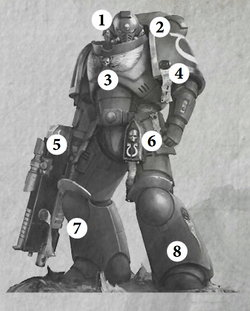
A Primaris Space Marine Intercessor of the Ultramarines Chapter wearing Mark X Tacticus Power Armour (see text to the left for corresponding numbers).
- Mark X Power Armour does not have a single appellation like earlier variants of Astartes battle-plate (such as Mark VII Aquila Power Armour). Instead, different variants of the same mark are worn depending on the Primaris Space Marines' combat role. Intercessor Squads, Hellblasters and many Primaris officers, for example, wear Mark X Tacticus Armour like the suit shown to the right. It offers substantial protection and allows the wearer great mobility. Inceptors, however, wear the Mark X Gravis variant, showcased below. Elements of several earlier marks of Astartes power armour are recognisable in the various incarnations of Mark X armour.
- Sloped pauldrons, or shoulder plates, are used to deflect enemy fire. Primaris Space Marines are trained to use these angles to deflect shots.
- The thickest layer of ceramite is over the chest-plate, protecting not just the power armour's cables, but also most of a Primaris Space Marine's vital internal organs.
- A Dominus-class Purity Seal.
- The Mark II Cawl Pattern Bolt Rifle is wielded like an extension of a Primaris Space Marine's weaponised physique.
- An Absolutis ballistic-appeasement autoreliquary allows for autosanctification of Bolt Weaponry in combat.
- Flanged poleyns (kneeplates), made of melded plasteel and ceramite, provide extra protection over vulnerable joints.
- Greaves. These incorporate gyroscopic stabilizers and can magnetise the soles of the armour's boots, allowing Primaris Space Marines to walk on metal surfaces in treacherous terrain, including zero-gravity environments -- essential for boarding actions in the cold battlefield of space.
History and Development
"Shells, blades, fire or claw - none shall slow the march of a power armoured Space Marine."
- — Excerpt from the Codex Astartes
Power armour has been in use since before the Age of the Imperium, worn by the techno-barbarians that dominated Terra during the Age of Strife. It was also worn by the early genetically-engineered warriors that formed part of the Emperor's retinue during his unification of Terra towards the end of the Age of Strife in the 30th Millennium.
In the armour's earliest incarnation, the suit was not fully sealed or life-supporting, this being unnecessary while its use was still confined solely to Terra. Over the history of the Imperium, power armour has developed into many different forms. Need, circumstances and the recovery of new materials and lost advanced technology, so-called archeotech, has shaped the armour's evolution.
The common image of the Emperor's Space Marines is of mighty warriors arrayed in imposing suits of armour made of ceramite plates, adorned with a bold two-headed Aquila on their chests. This pattern of power armour, dubbed the "Aquila Pattern," is the one most often seen among the Firstborn Space Marines, but is in fact just one of eight distinct "marks" seen on battlefields over the millennia.
All the recent types are still in active use, to varying degrees, by the existing Chapters of the Adeptus Astartes. Working examples of the older marks, meanwhile, are extremely rare and valued as a physical link to the glorious history of the Space Marines.
Older patterns of power armour are reserved for ceremonial guards or used as the badge of office of high-ranking officers. It may be noted that there appears to be a steady improvement in engineering and design through the years.
However this progress is not because of any particular invention or creativity. Rather, the changes were triggered by the gradual rediscovery of knowledge and materials from the Age of Technology, as the Emperor's Great Crusade reconquered the galaxy.
Following the end of the Horus Heresy, the genral stagnation of Imperial culture and technology meant that the advancements in power armour technology have been few and far between.
Mark I Thunder Power Armour
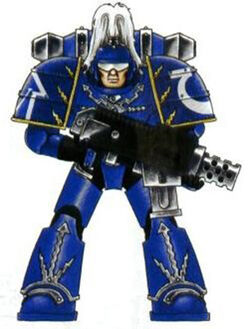
Mark I Thunder Pattern Power Armour - Ultramarines Legion
The first power armour suit type created for the Space Marines was the Mark I Thunder Power Armour, though the name was assigned after the fact and at the time of its use the suit was simply called "power armour." Neither fully enclosed nor airtight, it cannot be considered true power armour as that term was later applied in the Imperium, but paved the way for all future designs.
It featured a powered and heavily armoured torso that gave the wearer immense upper-body strength for grappling and subduing their foes. The power required to keep the suit working came from a backpack, a technological innovation that has been incorporated into every mark of power armour since. Its name was derived from the thunder and lightning symbol, the Raptor Imperialis, on the armour's plastron.
It was developed from the powered combat armour worn by the techno-barbarians that plagued Terra near the end of the Age of Strife. It was used during the Emperor's Unification Wars to retake and reunite Humanity's homeworld before the Great Crusade and was worn by the Thunder Warriors.
It was by no means unique to the first Space Marines -- in fact, the techno-barbarian warriors the Emperor fought during the conquest of Terra wore it too, and the Emperor's forces of genetically-enhanced warriors were wearing it even before the first true Space Marines were developed. However, because it was designed with fighting in a terrestrial environment in mind, it is not fully enclosed, with no means to support the wearer in a vacuum.
Only the upper body is powered, due in part to the fact that during the Emperor's conquest of Terra, ranged weapons were difficult to make due to technological constraints, and so a warrior's upper-body strength was his most important asset. This armour pattern takes its name from the thunderbolt and lightning symbol known as the Raptor Imperialis the Emperor used during the Unification Wars on Terra before he adopted the double-headed eagle known as the Imperial Aquila during the Great Crusade.
The emblem gives the suit its common present-day name -- Thunder Armour. This early armour was produced on a completely local basis. There was no standard design, individual suits varied heavily and their exact designs were often a matter of personal taste.
The main part of the armour is the massive powered torso which encloses the chest and arms. Coiled energy cables beneath the armour plating transmit energy from the power pack on the back to the arms, greatly increasing physical strength.
Since the fighting on Terra during this period was primarily close-quarters, the strength of a warrior's chest and arms was of paramount importance. The legs of this armour are not powered at all, but are enclosed in tough padded breaches, though simple steel plates were sometimes also used.
Although uncommon, the best-equipped warriors sometimes wore armoured greaves and armoured boots. However, this ancient suit of power armour was noticeably noisier than later models, perhaps due to the unpowered legs, making stealth operations nearly impossible in it.
Mark II Crusade Power Armour
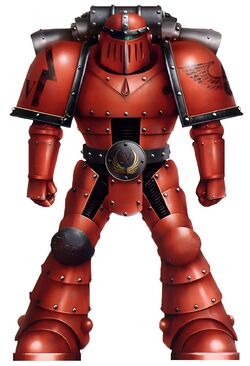
Mark II Crusade Pattern Power Armour - Blood Angels Legion
Mark II Crusade Power Armour was developed towards the end of the Age of Strife and was used during the dawn of the Imperium by the Space Marines who carried out the Emperor's Great Crusade to reunite the lost colony worlds of Mankind in a new Imperium of Man. After the conquest of the main planets of the Sol System after 798.M30 by the Emperor's new armies of Space Marines, the Mechanicum factories on Mars were set to work constructing a new and far more advanced type of power armour for the Emperor's newborn Space Marine Legions.
This armoured suit is commonly referred to as "Crusade Armour," since it was designed with the planned Great Crusade in mind. It was the first fully enclosed suit of Imperial power armour, making it suitable for the conquest of space and operations in a vacuum, and thus is actually considered the first true suit of power armour as that term is commonly used in the Imperium. It was designed as a fully enclosed suit with life-sustaining systems that now allowed the Astartes to fight in deep space and on alien worlds with hostile atmospheres or environments.

A schematic of Mark II Crusade Pattern Power Armour from the time of the Great Crusade ca. 800.M30
The armour was made up of microscopic circular armoured rings of ceramite fitted under and over each other, making this armour relatively tedious to repair. The larger armour plates composed of these microscopic rings were linked together to allow for a greater ease of movement and most of the power cabling for the suit was threaded inside the plating. These articulated sections of ring-shaped armour were present on both the torso and legs, and provided the Space Marine unparalleled mobility.
The Mars Pattern backpack retained a similar shape to that of the Mark I suits but now contained advanced life support equipment such as air-scrubbing, fluid recycling and emergency medical first aid systems as well as the power supply for the armour. The helmet was set in a fixed position attached to the gorget, but did allow the occupant to turn his head inside the suit. The Mark II was noted to have a more efficient power system to prevent overheating.
The helmet also contained electronic sensory devices and miniaturised cogitators (computers) that monitored the surrounding battlescape and fed visual and auditory signals directly to the Astartes' cerebral cortex through a neural feedback mechanism. This further enhanced the Astartes' already superhuman sight and hearing, while at the same time dampening any blinding flashes or deafening explosions. These so-called "Auto-senses," as well as the other internal improvements, all became standard equipment in every subsequent pattern of Imperial power armour.
In the 41st Millennium, these suits of power armour are extremely precious relics of the few Chapters that still possess a suit or two and are still used during formal ceremonies and rituals by some Chapters. These suits are often given to the Chapter's champions as actual battle armour in others.
Though quieter than the Mark I, Crusade Armour also is not intended for stealth, though the sight of an Astartes wearing this armour draws every Space Marine's mind to the glory of the Great Crusade before the disaster of the Horus Heresy unfolded and provides a major enhancement to unit morale.
Regarded by many as the most effective suit of power armour ever created, the Mark II was notoriously difficult to maintain and dropped out of common use by the 41st Millennium save as revered Chapter relics.
Mark III Iron Power Armour
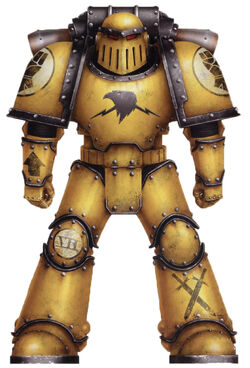
Mark III Iron Pattern Power Armour - Imperial Fists Legion
As the Great Crusade reached the planets towards the core of the galaxy, some of the worlds encountered were the Squat homeworlds, which were not pleased to find themselves the object of a Human galactic conquest, Emperor of Mankind or no. The Squats' independent and stubborn nature along with the conditions of the fighting in many of the Squats' subterranean holds spurred the creation of this new armour type.
High casualties suffered by the Legiones Astartes on these worlds and in other similar, close-quarters environments such as boarding actions and tunnel-fighting during the Great Crusade led to the development by the ancient Mechanicum of the Mark III pattern of power armour. The Mark III was best suited for voidcraft boarding actions and combat in confined subterranean tunnel complexes with little cover.
This armour was ideally used by Space Marines when cover was minimal and combat was a matter of a simple frontal assault. Because of this pattern of power armour's great strength, it became known as the "Iron Armour" or Armorum Ferrum in Imperial High Gothic. The Mark III was never intended to replace the Mark II armour but instead was a specialised suit to provide heavier protection than the normal Mark II suit when fighting in conditions similar to that found on the Squat homeworlds, in mines, subterranean complexes or the tight corridors of a voidcraft. It has more frontal protection than the Mark II armour, but the weight of the rear armour was lessened to compensate, making it unsuitable for regular combat duties.
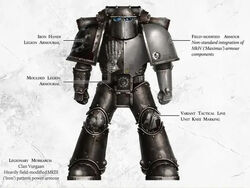
A heavily-field-modified suit of Mark III Iron Power Armour with non-standard integration of Mark IV Maximus components used during the Great Crusade by the Iron Hands Legion's Clan Vurgaan.
The suit uses a heavily armoured helmet with sloping plates designed to deflect shots to the left and right, thus inspiring its name as the Iron Pattern. This helmet pattern inspired the later Mark IV and VI helmet designs. The wedge-shaped helmet also formed the basis for the later distinctive Corvus Beak helmet of the Mark VI pattern.
Iron Armour clanks and grinds with the slightest movement, making it all but useless in stealth operations. However, the presence of such an imposing and ancient suit of relic power armour is a great honour for all Space Marines and its presence can greatly boost unit morale in combat.
Ostensibly a suit of modified Mark II Crusade armour, the Mark III featured additional armour panels on the greaves, forearms, thighs, chest and groin, plus larger shoulder plates. In the 41st Millennium the Mark III is now mainly worn as ceremonial relic armour.
Mark IV Maximus Power Armour
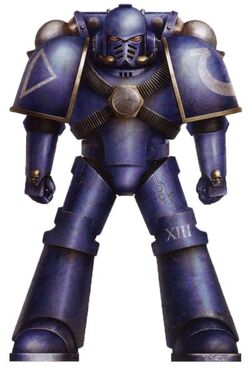
Mark IV Maximus Pattern Power Armour - Ultramarines Legion
As the Great Crusade reached its climax at the dawn of the 31st Millennium and the Imperium reached its zenith in terms of technology and strength, the Space Marine Legions found their original suits of Mark II Crusade armour wearing out. While some Legions chose to continue local production and maintenance, the ancient Mechanicum of Mars designed a new variant, which was to be called the Mark IV or "Maximus" Pattern since it was produced during the days of the Imperium's greatest glory.
At the Mark IV stage of power armour development, Space Marine armour began to take on an appearance recognizable to that of contemporary power armour patterns in the 41st Millennium, its primary change being the abandonment of the separate abutting plates of armour in favour of larger, inflexible armour casings incorporating flexible joints.
This marginally reduced an Astartes' mobility but was far easier to produce and maintain, and the suit was actually lighter and provided its wearer with more overall mobility due to the lessened weight, while not reducing the actual level of protection the suit provided compared to its Mark II counterpart.
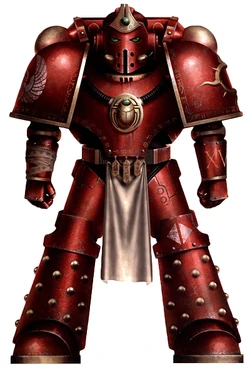
Mark IV Achean Pattern Power Armour - Thousand Sons Legion
Technical secrets from the Age of Technology recovered on newly conquered worlds during the Great Crusade allowed the Mechanicum to develop this more efficient pattern of armour, improving the quality of protection and reducing the suit's weight at the same time.
Improved armouring of the suit's power cables allowed the main arm and chest power supply cables to be safely relocated to the exterior of the armour, making it the first suit to have this feature, while the use of new materials reduced the size and number of cables. The various systems contained within the suit's backpack were miniaturised and made more efficient, allowing the new Phaeton Pattern backpack to be smaller, lighter and to make use of an altered exhaust system that provided a shape much closer to that of the later Mark VI and Mark VII patterns of armour in widespread use by the Firstborn Astartes of the 41st Millennium.
The Mark IV suit's helmet was a completely new design, the basic shape inspired by the sweeping front of the Mark III. In the Mark IV and later patterns the helmet was no longer fixed to the armour's neck plates, but moved with the wearer's head while still maintaining an environmental seal. This advancement represented the Artificers' increasing experience with neural connector gear and the new materials which flooded into the Martian workshops as the Great Crusade progressed.
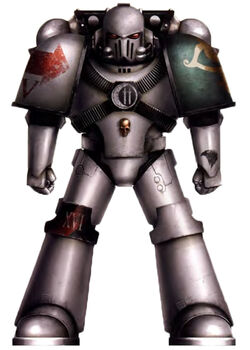
Mark IV Maximus Pattern Power Armour with variant pattern helmet - Sons of Horus Legion
Whilst standard patterns of armour were shared across the Space Marine Legions during the Great Crusade, variations on these templates surfaced in most of the Legions.
For instance, Mark IV Achean Pattern Power Armour arose as a local variation of Mark IV Maximus Power Armour, produced for the Thousand Sons Legion by the forges local to that Legion's homeworld of Prospero. More stylised than their standard armour, Achean Pattern battle plate was most often worn by XVth Legion Veterans.
The Praetor Pattern was a Mark IV variant used by the Ultramarines during the Great Crusade and Horus Heresy. Produced at Veridia Forge, an asteroid-based Mechanicum mining base in the Veridian System, it was not an accepted mark of the greater Legiones Astartes by the time of the Battle of Calth.
Mark IV power armour was envisioned at the time to be the ultimate and final type of Space Marine armour, able to offer the best protection in a variety of conditions. Many of the Space Marine Legions were entirely or partially re-equipped with it by the start of the Horus Heresy in the early 31st Millennium.
As a result of its widespread production and use prior to and during the Horus Heresy, Mark IV suits are the most common of the pre-Heresy relic armour patterns still in service with the Adeptus Astartes of the 41st Millennium. Notably, a few Chapters, such as the Red Scorpions and Iron Hands, are still capable of producing new Mark IV suits in the 41st Millennium.
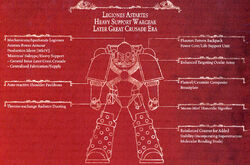
A schematic of Mark IV Maximus Power Armour during the later Great Crusade era.
This pattern of armour is the type of power armour still worn by most of the original Chaos Space Marines of the Traitor Legions, as they usually have access only to the technology they took with them into the Eye of Terror ten millennia ago. However, some Chaos Space Marines mix and match more modern pieces of armour with their ancient Mark II and Mark IV suits to replace damaged portions.
Those Space Marines who have turned Renegade since the Horus Heresy obviously wear the power armour that was current to the era when they first turned against the Emperor. Heretic Astartes often strip more modern pieces to upgrade their armour from the bodies of Loyalist Space Marines killed in battle.
Among Loyalist Space Marines of the 41st Millennium, being granted the right to wear a relic suit of this ancient form of power armour is a great honour and such an Astartes will be given greater respect than normal by his fellow battle-brothers and even Space Marines from other Chapters.
Mark V Heresy Power Armour
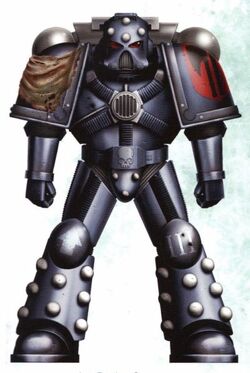
Mark V Heresy Pattern Power Armour - Executioners Chapter
The equipping of the Legions with Mark IV armour was only partially complete when the Horus Heresy broke out. Many of the newly-equipped Legions turned against the Imperium while many of the Loyalist Legions still possessed only Mark II Crusade Power Armour. With the extensive amount of war damage and constantly mobile operations that defined warfare during the Heresy, resupply for the Loyalist Space Marine Legions' damaged equipment was difficult or impossible.
This suit of power armour was developed by Space Marine Artificers and Techmarines as a solution to the supply problems caused by the Horus Heresy. It was manufactured from the most basic of materials, and it was easy to maintain. Almost all of its users used molecular bonding studs to hold the armour layers of plasteel and ceramite together, and these studs became a distinctive marker of this pattern of power armour.
In time, it became traditional for the studs to be found on the head, lower legs, and left shoulder plate of the armour. Since the highly advanced Mark IV suits became so difficult to maintain, the Mark V was defined by its flexibility, as it was capable of being repaired with either new or old materials, depending upon their availability.
In many cases, older, heavier power cabling was used, which created a weak point on the armour throughout the suit's composition. To deal with this problem, many Chapters' Techmarines reinforced these suits with an extra plate of ceramite fitted over the top of the original plates with molecular bonding studs, which as noted above were responsible for the armour's distinctive appearance.
Due to the sub-standard materials used in the construction of this armour variant, the Mark V tended to be heavier and more cumbersome than its predecessors and thus had a tendency to over-heat quickly. Many Space Marines had to endure sub-standard performance by turning down the power output of their backpack to prevent intolerable heat build-ups.
The helmet appears to be an early version of the Mark VII Aquila helmet derived from a modification of the Mark IV helmet, although it is significantly more primitive in its design.
After the Heresy, most examples of this pattern of power armour were dismantled and used for spare or replacement parts with other patterns of armour as the Chapters who emerged from the Heresy perhaps did not want to be reminded of those dark days of civil war and betrayal. However, this pattern of armour is still commonplace among the Traitor Legions of Chaos.
Heresy pattern armour carries memories and allusions to the Imperium's darkest hour, but also its greatest victory and the Emperor's Ascension. Other Astartes will offer a wearer of this pattern of power armour solemn respect. But members of the Inquisition, who know that this pattern of armour is particularly common among Chaos Space Marines, will be instinctively suspicious of any Astartes with such a close connection to the Traitor Legions.
Mark VI Corvus Power Armour

Mark VI Corvus Pattern Power Armour - Raven Guard Legion
This classic power armour variant can be traced back to the time of the Horus Heresy during which it was developed as a proper replacement for the Mark IV Maximus armour by the ancient Mechanicum and is still commonly used even in contemporary Space Marine Chapters of the 41st Millennium. It is characterised by the beak-like muzzle on the helmet and an auto-reactive shoulder plate covered with molecular bonding studs on the left shoulder of the armour.
The Mark VI suit, much like the Mark V, was intended to be extremely easy to repair and maintain by Space Marine Legions engaged in the constant warfare of the Heresy. It was built with dual technology circuits that allowed the easy replacement of rare or sophisticated parts with more common or basic alternatives with no degeneration in protection or performance. It also included new fail-safes such as duplicate power cabling in which the external power cables on the torso were backed up by failsafe circuits built into the armour. All other cabling was hidden beneath ceramite armour plates, including newer and much heavier leg greaves.
The left shoulder plate, which usually took the brunt of enemy fire, retained the molecular bonding studs found on the Mark V variant so as to be more easily replaceable.
The Mark VI pattern of power armour is the lightest form of the technology and has gained a reputation among Space Marine Techmarines as having the smoothest fit between its moving parts, despite the complete interchangeability with the Mark VII pattern of armour. This small difference means that Mark VI suits are often fitted with Jump Packs and used by Assault Marines, even if they still use a Mark VII helmet.
The finalised pattern of the Mark VI armour was named Corvus Armour in honour of the Raven Guard Legion's Primarch Corvus Corax. It looked little different from the Mark IV armour many of them already wore, but upon closer inspection, there were subtle differences in panel shape and bonding, the thicker material of the flexible joints, the solid greaves covering the knees. Most obvious was the bolt-reinforced left shoulder plate and the helmet design.
It did not escape the notice of the Raven Guard Legionaries that the conical faceplate design had a distinctive avian look to it, its beaked countenance looking the part of hunting birds of prey.
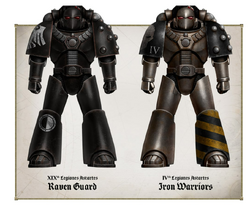
Mark VI Corvus Power Armour deployed on the Raven Guard and Iron Warriors Legions during the Horus Heresy.
This new mark of armour was Artificer-made and the first sets were shipped to the Raven Guard Legion ahead of all the other Loyalist Legions during the Horus Heresy, in recognition of not only their role in the technology's development process, but of the valiant sacrifice made by the XIXth Legion during the Drop Site Massacre of Isstvan V, and their resolute determination to rebuild their shattered Legion to rejoin the fight against Horus the Arch-betrayer.
With full production not yet begun on Mars and in the absence of reliable Legion supply lines, the ancient Mechanicum had designated all non-standard or stop-gap designs of power armour as the Mark V "Heresy" Pattern. Many of the improvisations made by the Raven Guard's armourium after the massacre were passed on to other Legions in the absence of replacement parts for the Mark IV suit.
The Mark VI was first deployed during a two-standard-year engagement in the Great Crusade through a sector of space claimed by the remnants of the broken Aeldari race known as the Scalland Campaign. The Scalland Campaign was to serve as the original field test for the first thousand sets of prototype power armour that would later come to be designated as Mark VI; though at the time it bore the provisional designation Mark V since the later Mark V Heresy Pattern was a response to battlefield conditions.
Small numbers of the Mark V armour had already been submitted to the Iron Warriors and Salamanders Legions, and both had expressed reservations about the lack of heavy plating when compared to earlier marks, pushing for the Mark V to be revised for a heavy assault role. It was deemed that a mass combat trial was required to determine the effectiveness of the original design before potentially abandoning it. Internal politics within the various Legion commands saw this honour bestowed upon the Raven Guard, depleted in number after the bloody fighting in the Aukum-Sothos Cluster.
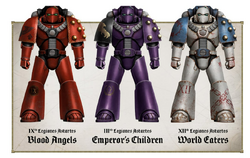
Mark VI Corvus Power Armour deployed on the Blood Angels, Emperor's Children and World Eaters Legions during the Horus Heresy.
Speculation at the time suggests that a faction amongst the primarchs and Legion commanders, led by Perturabo, intended this assignment to an under-strength Legion to be the death-knell of the Mark VI armour, leading to its replacement by a sturdier design. If this was so then the plan was to backfire spectacularly, for the Raven Guard performed admirably on the verdant Aeldari seed worlds of the Scalland Sector, utilising the advanced auto-senses and agility of the new armour to hound the Aeldari in a series of strike-and-fade attacks that decimated their already battered military forces.
Such was the success of the fighting in the sector, which eventually saw the expulsion of the Aeldari and the Imperium claim its rich worlds, that not only was the Mark VI armour approved for final deployment, but the majority of the improvements suggested by the Raven Guard were adopted.
The new armour, later dubbed "Corvus" Pattern Power Armour in honour of the Raven Guard, was placed into full-scale production only a few solar months before the outbreak of Horus' rebellion against the Emperor, re-designated as Mark VI from Mark V by the Mechanicum to account for the inclusion of the many stop-gap field modifications and repairs into the Legiones Astartes order of battle.
By the time of the Siege of Terra, the Mark VI was the most numerous pattern in service. The Loyalist Legions defending the Imperial Palace had whole chapters equipped with Mark VI armour. However, the Hereteks of the Dark Mechanicum hacked the data vaults of those Tech-priests still loyal to the Emperor to provide the designs to Horus and his forces. With countless Forge Worlds under the control of the Warmaster, production of Mark VI armour continued apace, and the Emperor's Children in particular used it en masse during the Siege of Terra. The predominance of the Corvus Pattern armour would continue well into the campaigns of the Great Scouring and into the present age.
In the real world, the beak or muzzle of this mark of power armour led fans to nickname this variant "womble armour" or "beakie armour", and a dictionary of the Orkish language in the 2nd Edition Ork Codex referred to Space Marines as "beakies."
This armour represents the style of the first Space Marine models released by Games Workshop in the 1980s and did not get its official canon Mark VI designation until after models with the Mark VII styling were released.
Mark VII Aquila Power Armour
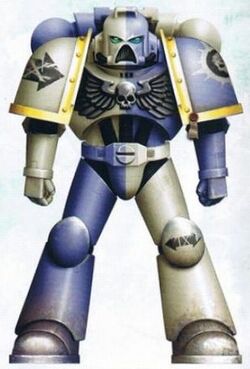
Mark VII Aquila Pattern Power Armour - Novamarines Chapter
This version of basic power armour was also known as Imperator Armour. It is the contemporary variant of power armour most commonly used by the Space Marine Chapters of the Imperium in the 41st Millennium. Mark VII armour was developed during the last stages of the Horus Heresy, and remains in use as the most common form of power armour more than 10,000 standard years later among the Firstborn Space Marines.
The armour features a heavy plastron, built to accommodate the chest cabling (the only real weakness on the Mark VI), which is emblazoned with an Aquila to show allegiance to the Emperor. The snub-nosed helmet was, once again, a derivation of the Mark IV Maximus helmet design, but made more compact so it was easier to wear in combat.
The Mark VII represents the final major development of Mark VI armour. While the final battle for Mars was underway with the Traitor Legions during their invasion of the Sol System in the Solar War, the Imperium realised the planet would eventually be lost. Mechanicum armour development teams were transferred to Terra to continue their tasks, incorporating their latest work into the armour type that would become the Mark VII. As Mars fell to Horus and the Warmaster turned to begin the Siege of Terra, the new type of armour began reaching the Loyalist Space Marines on Terra and Luna.
The Mark VII armour is characterised by the grim-looking Vox-caster (external vocalizer) on the faceplate, and the plastron displaying the Imperial Aquila or the Space Marine honour known as the Imperialis (a winged skull), which has given the armour different names such as Armorum Impetor ("Eagle Armour") or "Aquila Armour" ("Aquila" being the name of the two-headed eagle which symbolises the Imperium of Man).
During the Great Crusade, the Emperor had decreed that only the Emperor's Children Legion could wear the Imperial Aquila, the symbol of the Imperium and the Emperor Himself, upon their chest plates, as a sign of the great respect He held for the Emperor's Children and their Primarch Fulgrim's quest for perfection. But once the Emperor's Children allowed themselves to be corrupted by Slaanesh, the Emperor decreed as the Traitor Legions' final assault began upon the Sol System that every Loyalist Astartes was now worthy of bearing the Aquila upon his breast.
As the Mark VII is a further development of the technologies introduced in the Mark VI, both have a great deal in common, and parts from one pattern of armour are readily interchangeable with parts from the other in Space Marine Armouries.
A Mark VI helmet, for example, would fit straight onto a Mark VII suit, with no need for any reengineering by Techmarines and Artificers.
Mark VIII Errant Power Armour
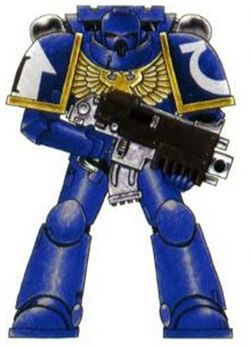
Mark VIII Errant Power Armour - Ultramarines Chapter
The Mark VIII Errant Pattern is an update to the Mark VII Aquila Power Armour, the first suit of new power armour produced by the Imperium since the Horus Heresy. This reality illustrates the extreme stagnation of Mankind's science and technology over the past ten Terran millennia since the fall of Horus and the Ascension of the Emperor.
On the surface, Errant armour looks much like a suit of Mark VII power armour, but with all the torso power cabling hidden behind articulated armour panels, a change based on the modifications made to many existing Mark VII suits once a majority of Adeptus Astartes Techmarines realised the cabling represented one of the Mark VII's only major points of vulnerability. Additional armour to protect the ribbed joints can be seen at the hips, and the ankles of the greaves have been adapted to provide a better range of movement.
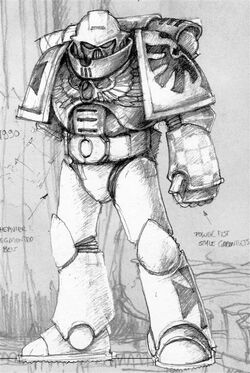
Mark VIII Errant Power Armour - Dark Angels Schematics
Mark VIII Errant armour is most readily distinguished from its predecessor by a raised collar or gorget at the front, and enhanced armoured plating for the Mark VII's torso power cables which were vulnerable to weapons fire. The new pattern also addressed the vulnerability issues of the Mark VII's neck joint, which had been know to act as a "shell-trap," as a projectile could hit the sloped breastplate and deflect up into the neck joint. The new gorget required a new helmet design, which caused problems for backward compatibility with the earlier helmet types, which cannot be easily fitted to a Mark VIII neck joint without extensive modification.
Mark VIII armour went into only limited production, and was seen in very limited numbers on the battlefields of the 41st Millennium. Full versions of this armour are almost never seen; however, it is common to find parts of it, particularly the power cabling protection plates and the gorget being used by Firstborn Space Marine officers.
Full suits of the Mark VIII has had limited deployment thus far, and tends to be reserved for Firstborn Veteran Marines as a sign of their rank. Mark VIII suits have mostly been issued to sergeants and higher-ranking Astartes officers, and as such the appearance of the Mark VIII has taken on an air of authority amongst the Adeptus Astartes. The Mark VIII is also more common among the Firstborn Space Marines of the Deathwatch Chapter, almost all of who are already Veterans when they begin the Long Vigil.
The Mark VIII is not widespread in the galaxy yet and it will take quite a few Terran centuries before the Forge Worlds of the Imperium have brought every Chapter up to the new standard.
With the introduction of the Primaris Space Marines and the Mark X suit in the Era Indomitus, it is unlikely that the Mark VIII will now receive wide deployment as the number of Firstborn Space Marines slowly declines.
Mark X Power Armour
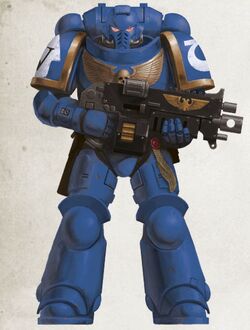
Mark X Tacticus Power Armour -- Ultramarines Chapter Intercessor
The Mark X is the latest development in power armour design developed and forged on Mars itself. This latest pattern of power armour was developed for the long-awaited project commissioned by the Ultramarines primarch Roboute Guilliman himself 10,000 standard years ago after the Horus Heresy -- to craft a new breed of transhuman warriors.
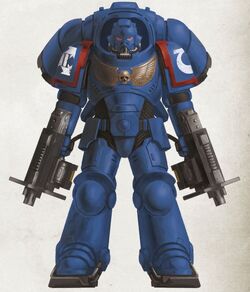
Mark X Gravis Power Armour - Ultramarines Chapter Inceptor
Developed over 100 standard centuries, utilising long-forbidden technology of ages past and their own sagacity, the Priesthood of Mars developed the Primaris Space Marines. This new breed of transhuman hero is bigger, more physically powerful and possesses faster reaction times than their original Firstborn Astartes counterparts.
These new warriors are the next step in the evolution of the Emperor's angels of death. They have been forged as reinforcements for the Imperium's beleaguered elite forces as their enemies close in for the kill in the wake of Abaddon the Despoiler's 13th Black Crusade and the birth of the massive tear in reality known as the Great Rift.
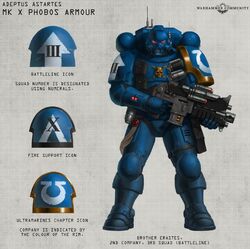
Mark X Phobos Armour - Ultramarines Vanguard Infiltrator
To aid them in battle, these gene-forged warriors are equipped with the most advanced arms, armour and equipment, including Mark X Power Armour, which combines all the most effective elements of ancestral power armour technology. These suits are currently worn by all Primaris Space Marines who have led the way in Guilliman's Indomitus Crusade to retake the galaxy from Mankind's many foes.
The Mark X is intended to be a modular design of power armour, more versatile than its predecessors and drawing upon the most advanced patterns of the past, particularly the Mark IV Maximus and Mark VIII Errant Patterns. Mark X Power Armour does not have a single appellation like earlier variants of Astartes battle-plate (such as Mark VII Aquila Armour).
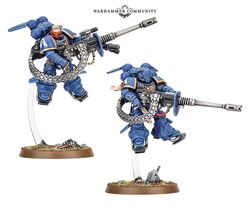
Mark X Omnis Armour - Vanguard Suppressors of the Ultramarines Chapter armed with Accelerator Autocannons.
Instead, different variants of the same mark are worn depending on the Primaris Space Marines' combat role. Regardless of its pattern, Mark X armour is designed to attach to a special undersuit worn by each Primaris Marine, enabling it to be fitted in different configurations according to need.
Intercessor Squads, Assault Intercessor Squads, Desolation Squads and Hellblaster Squads, for example, wear Mark X Tacticus Power Armour, which is the standard, multi-role pattern of the battle-plate used by most Primaris Marines.
Inceptors, however, wear the Mark X Gravis variant which possesses a built-in Jump Pack, retractable helmet shield, and a more robust, reinforced ceramite structure intended to withstand the forces of an assault from low orbit through a planetary atmosphere. The heavier build of Mark X Gravis armour is also favoured by Eradicators and Heavy Intercessors, who need the enhanced protection to better carry out their tactical roles.
A third variant is Mark X Phobos Armour. This suit's lighter-weight ceramite and streamlined design allow for greater mobility, and its servo-motors are engineered to be completely silent. This variant serves those Primaris Marines who take on the role of Reivers, Incursors and certain Vanguard Space Marines like Infiltrators and Eliminators. These Astartes are ruthless killers, trained in covert operations who operate behind enemy lines as saboteurs, assassins and infiltrators. All who wear the Mark X Phobos variant depend on stealth and secrecy to accomplish their missions.
Eliminator Squads utilise an even more stripped-down version of the same Phobos armour pattern, allowing them to operate with maximum stealth as they stalk their prey.
Like all Primaris battle-brothers, officers of the Chapter fight in Mark X Phobos pattern armour whenever the tactical situation merits it. Primaris captains and lieutenants of all companies will lead missions into the enemy's heart wearing such battle-plate, commanding equally silent warriors with undetectable battle cant.
Primaris Librarians replace their standard Mark X Tacticus Pattern raiment with Mark X Phobos armour when utilising the most subtle and illusory of their psychic powers, which rely on misdirection.
Vanguard Marine Suppressor Squads are clad in a fourth variant -- Mark X Omnis Armour -- which is a blend of the heavier Mark X Gravis configuration and the lighter Mark X Phobos versions favoured by other Vanguard Space Marine units. The Omnis Armour possesses a built-in Jump Pack similar to the Gravis variant. The result is a comparatively lightweight but extremely durable suit of power armour that can easily tolerate the extreme stresses of grav-drops, jump insertion operations and the thunderous recoil of portable heavy weaponry. Although they wear similar suits of Mark X armour as Inceptor drop troops, Suppressors do not strike into battle from low orbit like Inceptors, instead relying upon their Jump Packs and Grav-Chute arrays to manoeuvre into an enfilading position where their weapons tear through heavily armoured enemies and shred light vehicles.
All variants of the Mark X also allow for the utilisation of a new breed of Astartes weaponry, such as Mark II Cawl Pattern Bolt Rifles, Assault Bolters, Boltstorm Gauntlets, Auto Bolt Rifles, Plasma Incinerators and many others.
Mark X Power Armour Specifications (Tacticus and Gravis Variants)
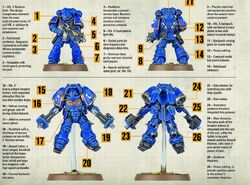
Mark X Tacticus and Gravis Power Armour Modular Design Elements (variants for Intercessors and Inceptors displayed)
- Mark X Tacticus Helm - This design, used by the Primaris Space Marine Intercessors, incorporates elements from the most sophisticated prior marks of power armour, the Mark IV Maximus and Mark VIII Errant Patterns, in addition to new systems and adaptations.
- Reinforced Vambrace - Primaris Space Marine sergeants, lieutenants and other officers incorporate communication cogitators.
- Poleyn - A kneeplate with raised guard provides added protection to the joint.
- Pauldrons - Shoulder pauldrons incorporate a second armour layer. Reactive armour and curvature increase the Mark X armour's protection potential.
- Mark II Cawl Pattern Bolt Rifle - Like all weapons in the bolter family, the Bolt Rifle fires small, self-propelled projectiles known as bolts which explode with devastating effect. The Mark II Cawl Pattern Bolt Rifle has a longer range and slightly more penetrating power compared to the standard-issue Firstborn bolter.
- Socket Ports - Socket ports on the cuisses (thigh armour) provide easy access for stim-injectors and diagnostic data-links.
- Honours - A Dominus-class Purity Seal and attached oath-papers are commonly worn.
- Ankle Joint - Heavily reinforced ankle join, (ref. Mark VIII Errant Pattern)
- Plastek Mech Belt - Plastek mesh belt and equipment pouches allow the wearer more waist movement.
- Mark X Backpack - The Mark X armour's backpack, with reinforced armour plates in line with the armour's overall design.
- Backpack Venting Ports - Backpack thermal venting ports are now incorporated into the backpack to allow for more efficient venting of waste heat.
- Power Cabling - Standard conduits for power distribution.
- Bolt Pistol - An additional compact model Bolt Pistol sidearm is now commonly worn as a backup weapon.
- Reinforced Undersuit - This reinforced undersuit adds to the comfort of the Astartes within as well as an extra layer of protection.
- Mark X Gravis Inceptor Helmet - The Mark X Gravis Pattern helmet used by Inceptors possesses an expanded rebreather filter for low-orbit combat drops.
- Helmet Cowling - A helmet cowling and gorget are able to seal off during orbital descent.
- Ablative Armoured Tasset Plates - Ablative armoured tasset plates provide additional protection on the hip and lower pelvis area.
- Inceptor Pauldron - Pauldrons with a third-layer of armour, compared to only two on the standard Mark X Tacticus Pattern armour.
- Assault Bolter - A short-ranged, hand-held variant of the Heavy Bolter which incorporates a blast shield and large box magazine with high-speed uploader.
- External Hydraulic Footplate - The Inceptor uses these footplates to control the power and direction of his Jump Pack's thrust.
- Grav-Chutes - Grav-Chutes, for controlling low-orbit drop speeds.
- Grave Vanes - Grav vanes provide optimised manoeuvrability during low-orbit drops.
- Guidance Thrusters - Secondary guidance thrusters integrated into greaves.
- Main Thrusters - The Jump Pack of the Inceptor variant of Mark X Gravis armour is fully integrated into the rest of the suit, unlike the lighter Jump Pack used by standard Firstborn Assault Marines, who wear it over the earlier marks of power armour as a separate device.
- Guidance Thrusters - These thrusters provide the variable thrust needed for the Inceptor to control his flight.
- Power Cabling - Power cabling on the back of the greaves provide auxiliary power to the armour's secondary thrusters.
Adaptability
One design feature of power armour patterns Mark VI through Mark VIII is their extreme ruggedness and high level of adaptability; it is fairly common within most Space Marine Chapters to see a suit combining parts originally created for three or four different patterns of suits, salvaged from dead battle-brothers on the battlefield. Mark VII armour, in particular, was created with this simple modularity in mind.
The many different Loyalist Space Marine Chapters of the present utilise all these different power armour patterns in differing ratios. Some choose to equip their Astartes with the most advanced patterns of armour available to them, while others cherish the older patterns and seek to maintain them for as long as possible in a combat-ready state.
It should be noted that the Mark I, II and III patterns of power armour are no longer in general usage by any Chapter's Battle Companies and are extremely rare relics of any Chapter lucky enough to still possess a complete suit of these types, though the Mark II and Mark III can be seen with slightly greater frequency among the Chaos Space Marines of the Traitor Legions.
The Consecrators Chapter, one of the Successor Chapters of the Dark Angels that inherited much of the original Dark Angels Legion's equipment during the Second Founding, will actually avoid the use of any suits newer than the Mark VI for its Firstborn Marines, and thus appears on the field as a Space Marine Legion from the legendary days of the Horus Heresy.
In many cases, only sections or portions of the more ancient patterns of armour remain, adapted to fit with more recent suits of Mark VI or Mark VII armour.
However, even a single shoulder plate or gauntlet that has seen millennia of service and countless battles is a treasured relic of a Chapter that brings much honour to the Astartes who has earned the right to wear it.
No Helmet Custom
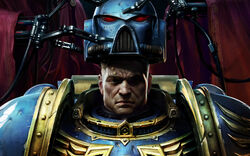
An Ultramarines Astartes armours himself for battle.
It is fairly common to see a Space Marine in combat without his helmet, especially among sergeants and officers, and many Astartes choose to remove their helmet when there is no immediate danger present.
Despite the added risk this practice presents, or perhaps because of that added danger, many Astartes see this practice as an honourable act of courage and even defiance to the Emperor's enemies.
The absence of a helmet does mean that the Astartes loses the Auto-senses that are housed within his armour, so those Space Marines who favour this custom often utilize earpieces or ocular enhancement devices, either as temporary additions or bionic replacements. Additionally, to insure a correct environmental seal, some of the proper rituals must be followed, which can take several more solar minutes.
In addition to the loss of their suit's Auto-senses, a Space Marine who chooses not to wear his helmet in combat cannot take advantage of the suit's environmental and life support systems, which means that this custom cannot be indulged in during combat in a vacuum or a hostile atmosphere.
When the helmet is off, the suit's vox link, while still usable through transceivers implanted in the armour's collar, can provide audio transmission only instead of the pictographic and videographic transmissions that are also possible when the helmet is worn.
However, an Astartes commanding his fellow battle-brothers in the field will often find their respect and unit cohesion enhanced due to the pride they take in their leader's unflinching willingness to face increased risk.
Of course, if a major fire-fight does break out or an Astartes unit enters an area of a hostile environment, putting one's helmet on as quickly as possible may be the only prudent course.
While the proper battle-prayers and rituals for donning a complete suit of power armour usually take a considerable amount of time, it is possible to replace a helmet quickly when the need is urgent.
After the helmet is replaced, it make take a few more minutes for the suit's Auto-senses and full vox link to become available, as the armour's Machine Spirit takes time to reactivate after an abrupt reawakening.
Amongst the Astartes, it is the Space Wolves who are the most fervent practitioners of this custom. In their case, it is no mere show of courage as the Canis Helix gifts them with a preternaturally acute sense of smell, rivalling that of natural wolves or trained scent-hounds.
Many Space Wolves are able to follow their targets, or the very flow of battle, thanks to minute changes in scent when fighting helmetless. The Space Wolves consider the added risk of a well-placed sniper shot to the head acceptable when equated with the ability to scent ambushes or the very moment an enemy will break or charge.
This habit of gaining information about a situation by scent is so natural to the Space Wolves that many feel slightly disoriented and claustrophobic when forced by circumstances to don their helmets.
Other Imperial Power Armours
Although power armour is most closely associated with the Adeptus Astartes, it is also used by the Sisters of Battle and some more martial-minded Inquisitors of all three of the Holy Ordos.
However, the Sisters of Battle and Inquisitors who use power armour do not possess the Black Carapace gene-seed organ implant, and so cannot be directly linked to the suit's advanced movement enhancement and fire control systems in the way Space Marines are, which decreases the armour's effectiveness.
Some high-ranking members of the Adeptus Mechanicus, the Machine Cult, use power armour. Enginseers of the Astra Militarum use it to protect them from enemy fire as they tend to the Machine Spirits of the Imperial Guard's vehicles.
Terminator Armour
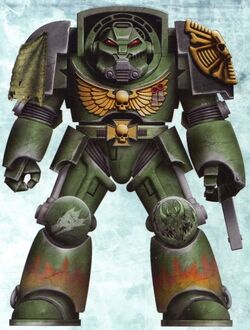
Salamanders Veteran Marine of the Firedrakes (1st) Company wearing Indomitus Pattern Terminator Armour.
Tactical Dreadnought Armour, more often called Terminator Armour, is one of the strongest forms of personal power armour in existence and is the heaviest and most resilient model the Imperium of Man has to offer.
It was developed for a mid-range of uses between the armoured chassis of a true Dreadnought and standard power armour. It is composed of a specially synthesized ceramite/plasteel alloy exoskeleton whose manufacture is now unknown to the Adeptus Mechanicus, with servo-assisted interfaces that link into the user's own neurological and muscular systems to enhance movement.
It is able to withstand tremendous punishment, and serves as a solid heavy-weapons platform in open-field combat. Due to its size, it is best deployed in close quarters such as the corridors of a starship, where the standard-issue Storm Bolter can be most effective.
The elite 1st Company of each Space Marine Chapter uses Terminator Armour, and only those Astartes who earn the Crux Terminatus of the 1st Company are permitted to wear this precious and rare model of power armour.
The most common pattern of Terminator Armour currently used by the Chapters of the Adeptus Astartes is the Indomitus Pattern.
Other, archaic patterns of Tactical Dreadnought Armour dating back to the time of the Great Crusade and the Horus Heresy exist in current use, but they are extremely rare and will be treated as venerated relics by those Chapters lucky enough to possess such an artefact of the Imperium's lost golden age.
Aegis Armour
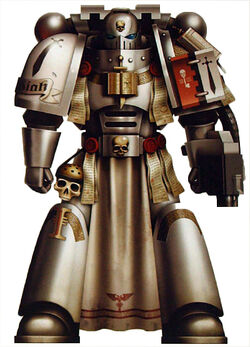
A Grey Knights Justicar in Aegis Power Armour
The elite Grey Knights Space Marines who serve the Inquisition's Ordo Malleus as its Chamber Militant wear Aegis Armour, a type of power armour that is incredibly well-crafted.
It is anointed and inscribed with prayers and wards, ritually consecrated and psychically-charged. Working in tandem with the Grey Knights' formidable psychic powers, the Aegis warding within the armour protects the wearer from psychic attack unleashed by the effects of the Immaterium and the Daemons it spawns, using the wearer's own psychic power as its energy source.
The armour's ritual blessings and psychic resonance also serve to confound the psychic perception of any enemy that draws upon the power of the Warp, resulting in an effect called "the Shrouding."
As well as its psychic properties, the armour itself incorporates a bolter weapon that is similar in function to a standard Astartes bolter, albeit with a larger design and more robust manufacture.
These weapons are common to the Grey Knights and often mounted on the wrist so that they might have a free hand to wield their Nemesis Force Weapons two-handed.
The suits are generally based on components from Mark VI, VII and VIII power armour designs, with a modified helmet design that is reminiscent of the Mark III.
Artificer Armour
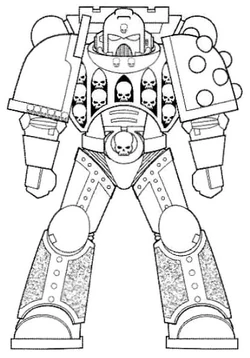
Adeptus Astartes Artificer Armour
Artificer Armour is the name given to individualised and heavily modified suits of power armour of many different patterns provided only to Space Marines who have proven themselves worthy of the honour, such as Chapter Masters, Company Captains, members of the Chapter Master's honour guard, or particularly skilled Veterans of the 1st Company or the various company Command Squads.
Though Artificer Armour and power armour are similar in appearance, Artificer Armour is as far beyond standard power armour as power armour is beyond the Carapace Armour used by the soldiers of the Astra Militarum.
Ingeniously designed damage control mechanisms and superdense materials allow most suits of Artificer Armour to offer a much greater degree of protection than standard power armour, even rivaling that offered by Terminator Armour in some cases. Artificer Armour cannot, however, make use of weapons as powerful as those available to Astartes in Terminator Armour.
A suit of Artificer Armour is an extremely valuable relic for a Space Marine Chapter and will usually have belonged to the Chapter's greatest heroes. Many elements of the suit will have been replaced or repaired over the long years and its heraldry altered for each wearer, but it is still held to be the same suit of armour and so is venerated for its history.
Techmarines also wear a form of Artificer Armour. These suits are rarely as old and venerated as the others possessed by the Chapter, but are essentially suits of power armour that have been heavily modified and improved by several generations of Techmarines.
Such suits usually contain a vast array of mechanical interfaces and built-in servo-tools to aid a Techmarine in his duties for the Chapter.
Some suits of Artificer Armour date back to the time of the Horus Heresy or even the Great Crusade. Forged by the master craftsmen of the ancient Mechanicum, these superior relic power armours are often highly embellished with ciphers of strength and durability, while some of wildly differing designs are far older than the present age and owe their origins to the forgotten zenith of Human technological might during the Dark Age of Technology.
Adepta Sororitas Power Armour
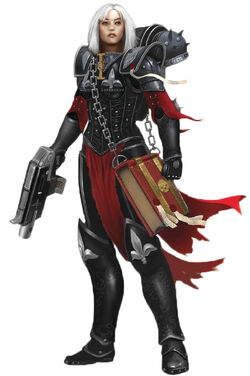
A battle-sister wearing Adepta Sororitas Power Armour.
The Orders Militant of the Adepta Sororitas, better known as the Sisters of Battle, use a lighter, less bulky version of power armour.
This variant armour is based upon the same archaic systems as that worn by the brethren of the Adeptus Astartes. Commissioned by the renegade High Lord Goge Vandire, it is the only part of his legacy that was not removed along with his head during the Reign of Blood of the 36th Millennium.
Created initially by the forges on Mars for the Adepta Sororitas, this lighter variant of power armour provides excellent protection and increased strength with little to no reduction in movement speed or agility.
Although, as the Sisters of Battle are not implanted with the Black Carapace that allows Astartes to cybernetically interface fully with their own armour, they must forego the more advanced life-support systems and strength-enhancing abilities used by the Space Marines.
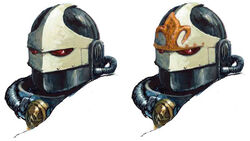
Sabbat Pattern Helm (from left-to-right); Standard and Celestian
The armour uses a similar power supply as the armour for the Adeptus Astartes and does not run out of energy unless damaged. As an optional item, battle-sisters also sometimes wear the Sabbat Pattern Sororitas Helm, the standard pattern worn by the majority of battle-sisters since the mid-38th Millennium.
This helm contains an integral rebreather, allowing the sister to operate in total vacuum for limited periods. The visor provides full-spectrum filtering and limited psycho-oculal buffering, allowing the sisters to fight on where a less well-equipped warrior would be rendered insensible by adverse battlefield conditions.
A second variant of the Sabbat Pattern Helm has the fleur-de-lis symbol of the Sisterhood mounted upon the front, an honour normally reserved for those sisters who have performed with exceptional courage and honour in combat. It is also common amongst the elite Celestian squads.
For the battle-sisters of the Calixis Sector, this helm is issued only after they have proven themselves worthy of wearing it.
Vratine Armour
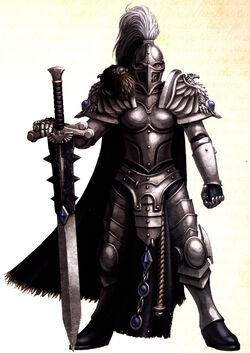
A Vigilator Mistress of the Argent Lynx Vigilator Cadre wearing the Sisters of Silence's trademark Vratine Armour, Voidsheen Cloak and armed with an Execution Blade.
When a sister-aspirant of the Sisters of Silence takes her final oaths of duty and says the last words she will ever utter aloud in her lifetime, she is given her panoply of war: the Vratine Armour -- literally "the armour of the oath."
It is a subpattern of technologically-advanced battlegear which shares design elements with both the power armour of the ancient Legiones Astartes and the silicate-mesh of Selenite void-mail, though unlike either of those famed armours, it is not -- at least without additional gearing -- fully environmentally sealed or designed for extended operations.
It does, however, provide formidable protection from ballistic impacts and directed energy weapons, and is tailored and forged uniquely to its intended wearer to allow for their complete freedom of movement and to augment their reaction speed.
Space Wolves Runic Armour
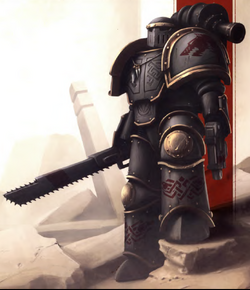
A Space Wolves Legionary wearing modified Mark III Ætheric-rune Armour during the Horus Heresy era.
In ancient times, the Space Wolves Legion was known to have among its most prized panoply of war a number of highly customised suits of Artificer Armour, known as Ætheric-rune Armour, which was fitted with intricately woven psycho-ætheric induction circuitry which acted as a loadstone, absorbing and negating psychic forces directed against the wearer.
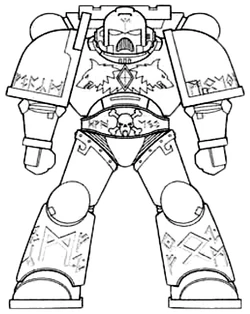
Lupio Pattern Mark XII Runic Armour
These artefacts were believed to be produced albeit in very limited amounts by the Legion itself, although from what pattern or rare materials remain unknown.
To the idiosyncratic beliefs of those within the Legion, the phenomenal protection the armour provided was due to the ritual rune patterns the circuitry formed, which they believed armoured the warrior's soul as much as it did their flesh, while Imperial observers dismissed this notion as mere superstition and pointed to an underlying, if ill-understood, technological basis to these rare and uniquely forged suits of armour.
In the 41st Millennium, the Space Wolves still grant valiant members of their Chapter specially crafted suits of power armour inscribed with psychic Runes of Protection by the Space Wolf Rune Priests (essentially that unusual Chapter's unique Librarians). These runes provide the wearer of Runic Armour with an enhanced defence against psychic attacks.
This armour is created by the Space Wolves Chapter's Iron Priests (Techmarines) and officially codified by the Adeptus Mechanicus as the Mark XII Lupio Pattern, though the suits can look like any of the standard patterns of power armour described above, though because of their antiquity, many of these suits are earlier patterns than the Mark VI.
Those valiant enough to be gifted Runic Armour are doubly blessed, for their shield is not only the pinnacle of the Iron Priest's art, but also the work of the mystic Rune Priests.
Ignatus Power Armour
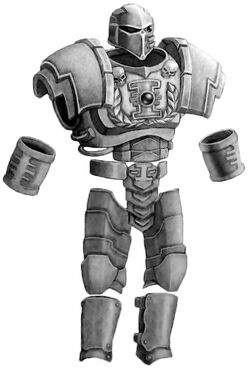
A suit of Ignatus Pattern Power Armour often used by Inquisitors in the field.
Although not as durable as the suits of power armour worn by the Adeptus Astartes, Ignatus Power Armour is a far step above the patterns of combat armour sold to dilettante Imperial nobles and mercantile cartels.
Ignatus Pattern Power Armour is produced by skilled Adeptus Mechanicus artisans for the express purpose of equipping agents of the Inquisition.
Many militant Inquisitors equip themselves with Ignatus Armour, girding their bodies with ceramite just as they gird their souls with faith.
Like all suits of power armour, Ignatus Armour consists of an ingenious merging of thick ceramite protective plates and a complex system of muscle-like, electrically motivated fibrebundles to augment the user's movements and strength.
This technology is so miraculous that one wearing power armour can move and fight as if they were unencumbered, their suit's augmetic systems compensating entirely for the armour's crushing weight and bulk.
Ignatus Power Armour provides the following benefits to its bearer: The suit's removable helmet contains the equivalent of integral, high-quality photo-visors (providing the user with darkvision and the ability to see in multiple spectrums of light, as well as making the wearer immune to the effects of photon flash grenades), a vox micro-bead, and an integral auspex sensor suite.
These devices can be controlled by speaking to the armour's Machine Spirit (artificial intelligence), or the wearer can commune with their armour directly if they have a cerebral plug, Mind Impulse Unit, or similar device implanted within their cerebral cortex.
When the helmet is attached, the suit has a self-contained life sustainer that allows the bearer to ignore toxic atmospheres and gasses, and even survive underwater or in a vacuum. The system operates as long as the armour has power.
The suit has an integral backpack power supply that can last for five solar days of continuous combat operations (if the power armour is not being used in combat, its power supply can last for far longer).
If the suit becomes unpowered, it becomes a rigid tomb for the wearer, who must make a hellish effort to simply move. The helmet's Machine Spirit does open exterior vents automatically before powering down, so that its wearer does not suffocate.
The first suits of true power armour date back to the Emperor's Great Crusade to reclaim the galaxy, and many are maintained for standard centuries or millennia as much as religious relics as protective gear.
Ignatus Armour is no exception, and it is not uncommon to find suits encrusted with religious iconography, inscribed with holy runes of warding, or inlaid with subtle defensive systems.
Ignatus Power Armour is commonly inlaid with Hexagrammic Wards which provide the wearer with a greater ability to resist psychic powers or attacks.
Custodian Armour
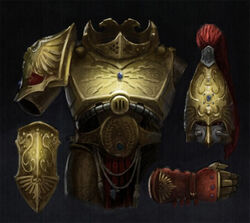
A suit of auramite Custodian Armour used by the Adeptus Custodes.
The Custodians of the Adeptus Custodes, the bodyguard of the Emperor of Mankind, also wear power armour of a design created just for them during the days of the Great Crusade. The panoply of the Adeptus Custodes, known as Custodian Armour, represents the pinnacle of the armourer's art.
Far more sophisticated than production-model Space Marine power armour, it is fashioned with rare golden auramite alloy such as that used for the armour the Emperor Himself wore in battle, rather than the standard ceramite used in all other forms of Imperial power armour.
Each suit is unique to the Custodian Guard who wears it, as it is customised to its user, a finely wrought suit of master-crafted battle-plate in the Custodes' traditional golden colour, each a work of art in its own right and highly individualised after the fact by its user.
Custodian Armour is also fitted with arrays of proximity sensors and Refraction Field generators to further enhance its formidable defences.
Auramite is an incredibly rare substance, whose natural colouration is a shining gold, a hue entirely appropriate for the Emperor's personal guardians. However, through closely guarded alchemical processes, auramite can be tinted, or its colour changed altogether on a molecular level. It is a costly and painstaking process, but considered far more suited to the Custodians' importance in the Imperial hierarchy than simple repainting.
Auramite is almost inert at a quantum level, making it far less of an inhibition to the manipulation of Aetheric energy by a psyker than other protective materials. During the Siege of Terra, the Emperor wore His own auramite battle-plate while fighting His immaterial battle with the powers of Chaos within the Warp. Bare skin is better when unleashing psychic power, but had the Emperor not worn it, the immense energies He unleashed while sitting upon the Golden Throne would have burned His flesh to the bone.
Chaos Power Armour
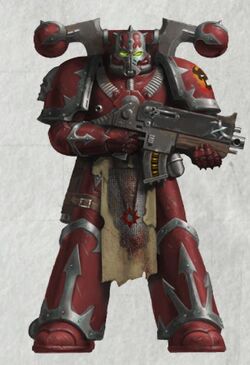
A suit of the Warp-tainted power armour worn by a Chaos Space Marine of the Word Bearers Traitor Legion, Brother Kar'Gorax, the Arch-Tormentor of Hadravar VII; note the Anvilus Pattern backpack which is much more common among Heretic Astartes than Loyalist Space Marines, as its enhanced void-manoeuvering abilities are not compensated for by its inferior rad-shielding.
Power armour is the standard by which all other forms of Human protection in the galaxy are measured. The first forms of power armour were constructed in Humanity's distant past, during the Unification Wars, to reunite Mankind on its birthworld of Terra.
However, by the time of the Great Crusade, the Emperor equipped His Space Marine Legions with the first known suits of power armour.
At the time of the Horus Heresy in the early 31st Millennium, Mark II Crusade Power Armour had all but disappeared from the Space Marine Legions, replaced by the much improved Mark IV Maximus Pattern, with the exception of those Legions still fighting on the Eastern Fringe of the galaxy.
Even so, during the fierce battles to come, both sides were forced to reinstate older marks of power armour to replace their losses as well as scavenging and cannibalising armour from the battlefields. When the Warmaster Horus rebelled and half the Legiones Astartes joined him, they took their power armour with them.
The armour of the Traitor Legions that fled into the Eye of Terror still reflects these turbulent times, often featuring distinctive studded and rivetted plasteel plates rather than the smooth ceramite of the later designs. Exposed power cables that blend with sinew and vein remain a common feature of Chaos Power Armour and most Chaos Space Marines individualise their armour with crests, horns, skulls and chains. Additionally, many Chaos Space Marines still utilise the antique Great Crusade-era Anvilus Pattern backpack unit -- this variant has enhanced stabilising thruster vents to aid in void operations, but inferior rad-shielding from the backpack's reactor unit compared to more modern patterns.
Quite often, a Chaos Space Marine's power armour will have been altered by long exposure to the Warp. It may have sprouted spines or bony ridges, be covered in a layer of scales, or flicker with arcane and corsucating energies. The competition for new or replacement armour parts is fierce amongst the Traitor Legions.
Some Traitor Legionaries still have their original power armour suits, preserved through diligent effort or by the vagaries of the Warp. Others maintain newer marks of power armour -- looted from fallen foes or because the Heretic Astartes in question is a more recent convert to the Ruinous Powers.
Chaos Space Marines who have only recently become Renegades may have armour that has changed hardly at all from their former Chapter's standard livery, except for the deliberate defilement or removal of badges or symbols of allegiance to the Emperor of Mankind. Some Chaos Space Marines thus possess suits of the advanced Mark VIII Errant Power Armour, which is much coveted by other Traitor Marines and can earn the wearer greater prestige among the forces of Chaos. Some others may even have mismatched suits, with pieces replaced piecemeal as they fail. However, the Traitor Legionaries are not the only servants of the Dark Gods who possess power armour.
During the Great Crusade and in the 10,000 standard years since, suits of power armour have been constructed for baseline Human physiology. These "mortal" suits of power armour do not possess all of the complex subsystems of the original Space Marine Legion power armour, but they make normal Humans in service to Chaos formidable warriors nonetheless.
Power armour is more than simply protective gear. It is also defined by its numerous sub-systems, a host of devices that augment the wearer's combat prowess until he is the consummate warrior. Some of these systems are shared across mortal and Legion power armour, while others are limited to the Heretic Astartes only.
However, the forces of Chaos do not have access to the resources of the Imperium, including its massive foundries, forges, manufactoria, and supply depots. Many suits of power armour were originally Imperial in manufacture, having fallen into the hands of Renegades centuries or even millennia ago. Though they may have started with their systems entirely intact, standard years without proper maintenance and replacement parts means certain sub-systems may no longer be operable.
Unique is the suit of power armour that survives a conflict unscathed. Through long Terran centuries of combat, hundreds of repairs, and the corruptive influence of the Warp, Chaos Power Armour can change radically in appearance over time.
Videos
Trivia
Mark I Thunder Armour
Thunder Warriors are rarely mentioned in the Warhammer 40,000 background, yet one called Babu Dhakal (originally known as Arik Taranis) appears in the Horus Heresy novel The Outcast Dead.
Thunder armour was one of the last marks of power armour to be sculpted, the model intended as a collector's model to complete the set rather than as a gaming piece.
Mark II Crusade Armour
The Mark II's helmet was originally fixed to the gorget, meaning it would not turn with the wearer's head. When Forge World released sets of Mark II armour, they redesigned the helmets to enable more modelling options. The helmet was also the first part of the armour to be designed, drawn first in early concept sketches, with the armour then designed to match.
Mark III Iron Armour
The Ultramarines tank commander Sergeant Antaro Chronus wears a suit of Mark III Iron armour.
The Mark III helmet was loosely based on a medieval frog-mouthed helm, but with a more industrial feel to it. The helmet design was used as the starting point for the helmets worn by the power-armoured Grey Knights models that came out 20 years later.
Mark IV Maximus Armour
The backpacks worn by Space Marines were originally meant to be jet packs -- there's even a piece of artwork in the 1988 Warhammer 40,000 supplement Chapter Approved that showed them using them. The round nozzles on either side of the backpack are now categorised as stabiliser jets for use in zero gravity.
Mark V Heresy Armour
Designing older suits of power armour proved quite tricky at times. They had to look older and less developed than Mark VI and VII power armour, but in the lore they were described as more technologically advanced. Heresy pattern armour proved one of the hardest designs to work on, an amalgamation of old and new designs on one suit. The bulldog-like Mark V helmet is based on the Terminator helmet.
Mark VI Corvus Armour
The Space Marines in the first Warhammer 40,000 plastic kit (the now famous RTB01 box) wore Mk. VI power armour. The RTB01 models were meant to have boots like the first Imperial Space Marine, but the injection moulding technology of the late 1980s made it impossible. Instead, they were redesigned with flared greaves, a design that’s been synonymous with Space Marine power armour ever since.
Mark VII Aquila Armour
The face grille on the Mark VII armour came about because the designers wanted to make the Space Marine helmet look more aggressive. The brow was made more pronounced to emphasise the effect. The 1st Edition Rogue Trader rulebook even features a conversion of a Space Marine in Mark VI power armour with his nose cut off! He's regarded as the first step on the Mark VII design path.
Mark VIII Errant Armour
Mark VIII armour was an adaptation of Mark VII armour, both in the lore and in real life. It was actually the third suit of power armour to be designed, though among the last to appear as a miniature.
See Also
- Artificer Armour
- Carapace Armour
- Conversion Field
- Displacer Field
- Flak Armour
- Refractor Field
- Rosarius
- Stasis Field
- Terminator Armour
Sources
- Codex Adeptus Astartes - Space Marines (8th Edition), pp. 10, 23, 68, 71
- Codex Heretic Astartes - Chaos Space Marines (8th Edition), pg. 63
- Black Crusade: Core Rulebook (RPG), pp. 173-175
- Codex: Chaos Space Marines (6th Edition), pg. 37
- Codex: Grey Knights (5th Edition), pp. 21, 63
- Codex: Space Marines (5th Edition), pg. 102
- Codex: Space Marines (6th Edition) (Digital Edition), pp. 26-27, 221-225
- Codex: Space Marines (8th Edition) (Revised Codex), pp. 12, 24, 70, 76
- Codex: Space Marines (9th Edition), pp. 40, 141, 175
- Codex: Space Wolves (5th Edition), pg. 61
- Codex: Vanguard Space Marines (8th Edition), pg. 7
- Codex: Witch Hunters (4th Edition), pg. 19
- Dark Heresy: Ascension (RPG), pp. 143-144
- Dark Heresy: Blood of Martyrs (RPG), pg. 118
- Dark Heresy: Daemon Hunter (RPG), pg. 133
- Deathwatch: Core Rulebook (RPG), pp. 160-163
- Deathwatch: Rites of Battle (RPG), pp. 148-153
- How to Paint Space Marines
- Imperial Armour Volume Ten - The Badab War, Part Two, pp. 168-169
- The Horus Heresy - Book One: Betrayal (Forge World Series) by Alan Bligh, pp. 22, 140
- The Horus Heresy - Book Two: Massacre (Forge World Series) by Alan Bligh, pg. 17
- The Horus Heresy - Book Three: Extermination (Forge World Series) by Alan Bligh
- The Horus Heresy - Book Seven: Inferno (Forge World Series) by Alan Bligh, pp. 117, 131, 242, 249, 251
- Imperial Armour Volume Three - The Taros Campaign, pp. 48-50
- Master of Mankind (Novel) by Aaron Dembski-Bowden
- Know No Fear (Novel) by Dan Abnett, pg. 20
- Warhammer 40,000: Compendium (2nd Edition), "Space Marine Power Armour," by Rick Priestley
- Warhammer 40,000: Compilation (1st Edition), "Warhammer 40,000: Space Marine Armour," by Rick Priestley, pp. 18-26
- Warhammer 40,000: Core Rulebook (8th Edition), pg. 60
- Warhammer 40,000: Rogue Trader (1st Edition), pp. 115-116
- Space Marine (1st Edition), pp. 8-9
- White Dwarf 129 (UK), "Space Marine Armour" by Rick Priestley
- White Dwarf 469 (UK), "Armour Through the Ages"
- Deliverance Lost (Novel) by Gav Thorpe, pp. 298-300
- Psychic Awakening - Blood of Baal (8th Edition), pg. 33
- The End and the Death: Volume 1 (Novel) by Dan Abnett, Part 1, Ch. 1
- Warhammer Community - Power Armour Through the Ages
- Warhammer Community - New Warhammer 40,000: The Indomitus Crusade & the Dark Imperium
- Warhammer Community - A New Breed of Hero
- Thousand Sons Achean Pattern Armour Upgrade Set
- Warhammer Community: Shadowspear Focus - Vanguard Units
- Warhammer Community - Warhammer: The Horus Heresy – A Brief History of Mark VI Power Armour

